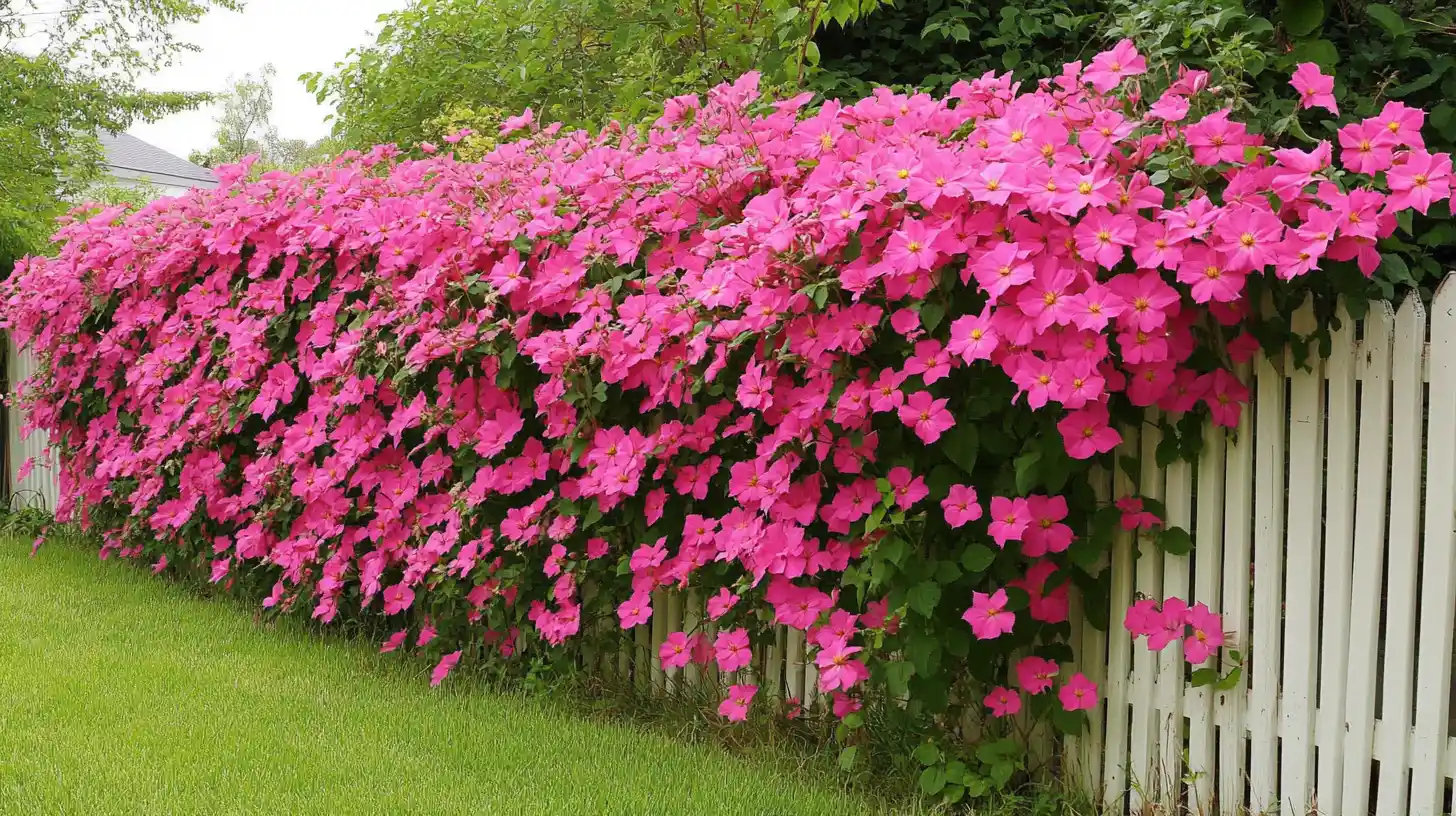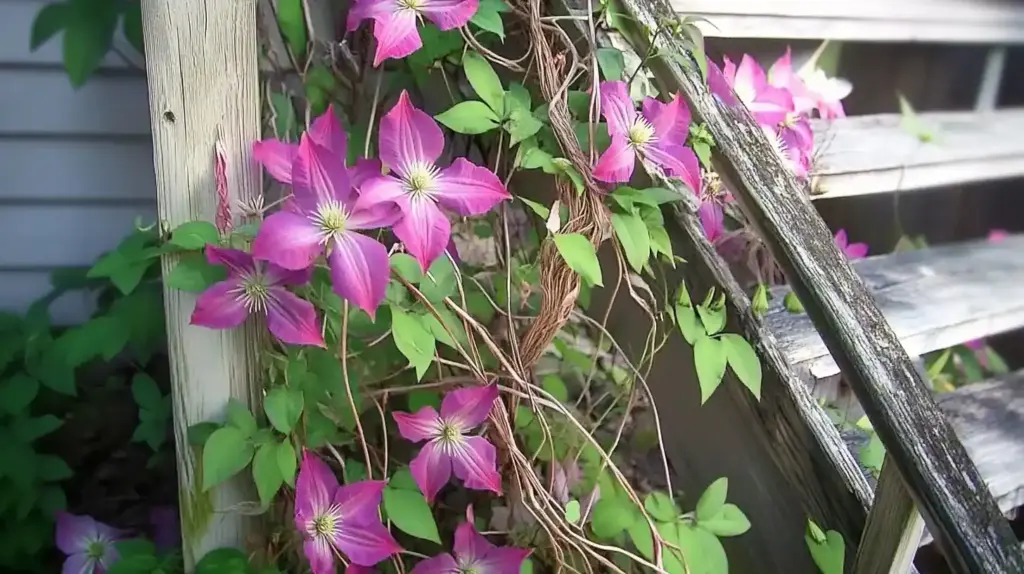Few flowering vines can rival the elegance, versatility, and sheer variety found across the many types of clematis available to home gardeners. With hundreds of cultivars—ranging from compact, container-friendly selections to vigorous climbers that effortlessly scale trellises and fences—types of clematis offer endless opportunities to elevate your garden’s beauty. Whether you prefer the drama of large-flowered hybrids or the whimsical charm of bell-shaped blooms, there’s a clematis variety perfectly suited to your space and style.
Clematis isn’t just admired for its good looks. Gardeners love it for its wide blooming range, ability to attract pollinators, and performance from early spring through fall. With flowers in nearly every color—purple, pink, white, red, and even cream—types of clematis bring waves of vibrant color across the seasons. Even better, breeders continue to develop exciting new cultivars with improved disease resistance and reblooming habits.
If you’re growing in containers or limited space, be sure to check out our clematis container growing guide for tips on soil, pruning, and support. In this article, we’ll explore some of the most eye-catching types of clematis, including long-time favorites and stunning new introductions—so you can choose the perfect one for your garden, no matter how sunny or shaded your spot may be.
Table of Contents
🌼 Featured Clematis Varieties: Eye-Catching Options for Every Garden
With so many types of clematis to choose from, knowing a few standout cultivars can make planning your garden a whole lot easier. Here are some top picks across different color palettes, bloom sizes, and growth habits:
🌺 Bold & Beautiful Blooms
Rebecca
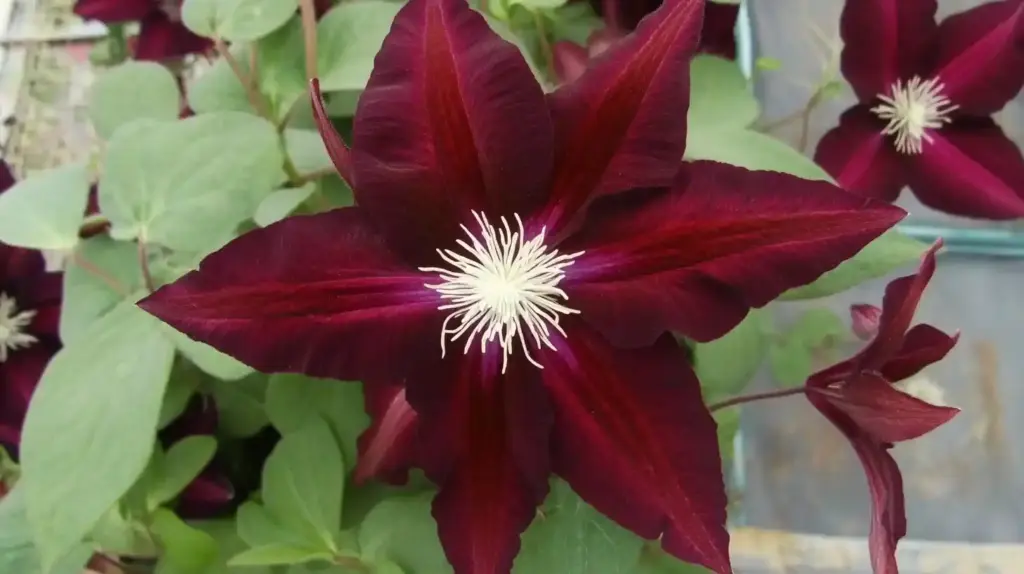
A dramatic showstopper, ‘Rebecca’ features deep scarlet-red flowers with creamy yellow anthers. Blooming in late spring and again in late summer, it’s ideal for adding passion and energy to arbors or fences.
Fireworks
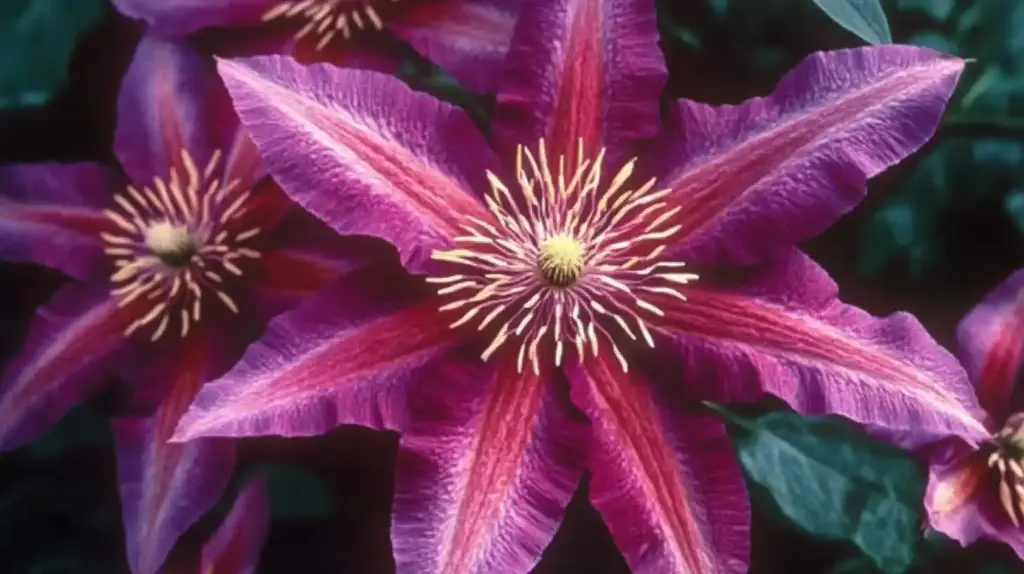
True to its name, this clematis bursts with 8″ purple flowers accented by pink stripes. With a second flush later in the season, ‘Fireworks’ is a favorite for those seeking continuous color.
Rosemoor
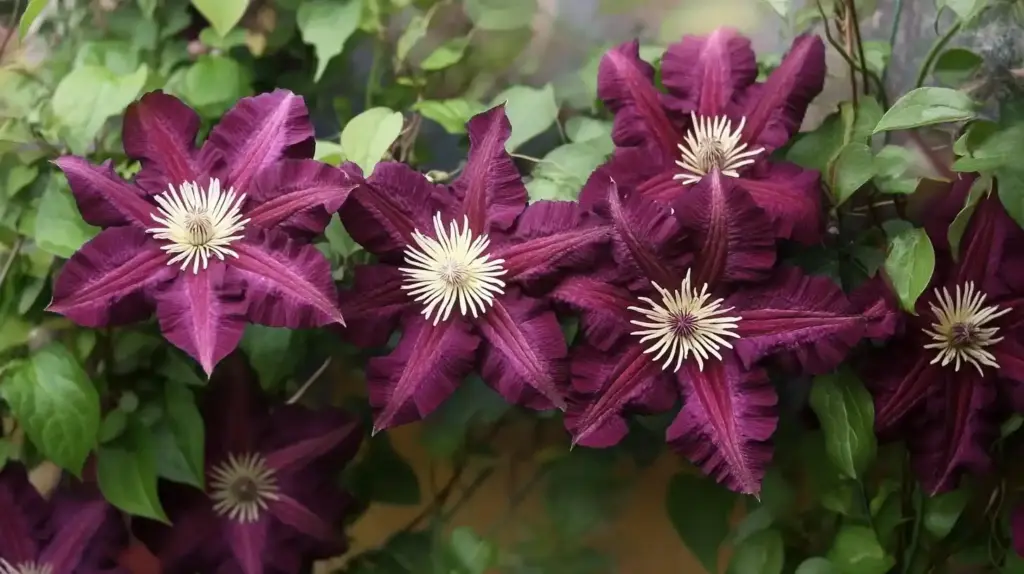
Known for one of the longest bloom periods (May–September), this cultivar dazzles with reddish-purple 5–6″ blooms and excellent disease resistance.
🌸 Soft & Elegant Choices
Guernsey Cream
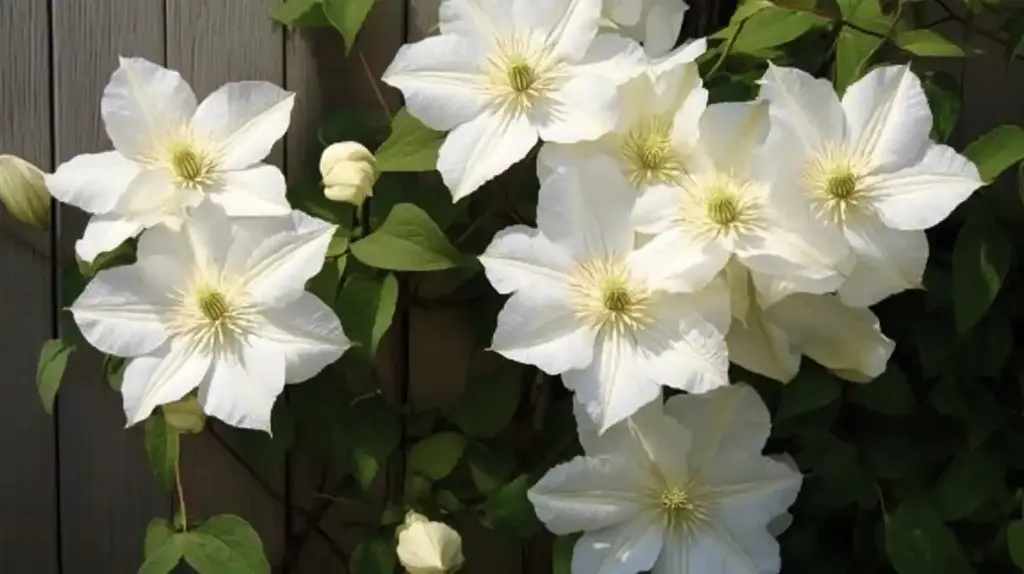
Creamy white petals with pale green undertones make this variety a serene and sophisticated garden addition. It reblooms with vigor and pairs beautifully with pastel companions.
Hyde Hall
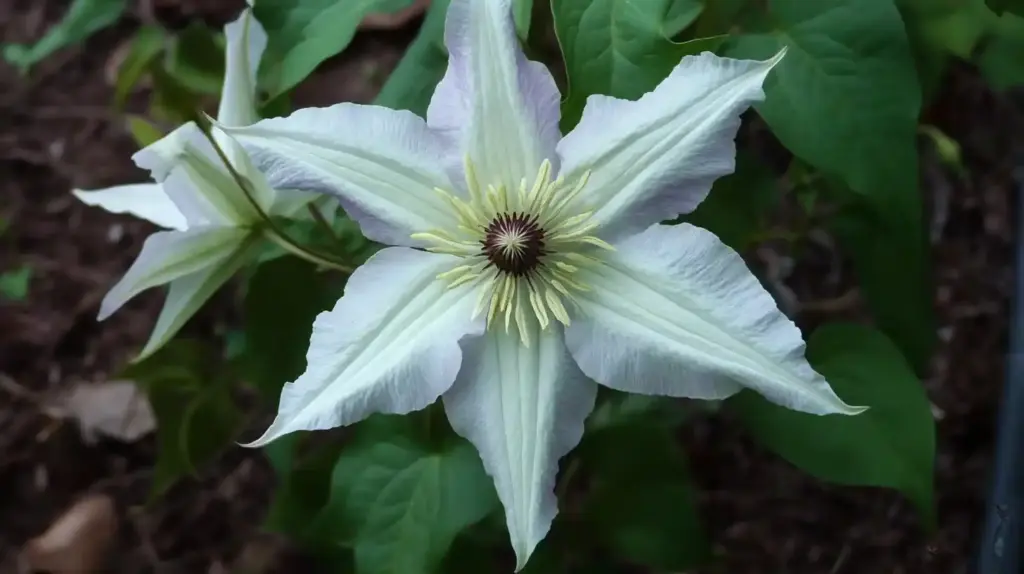
Semi-double white blooms with chocolate-colored anthers give this compact vine a chic, classic appeal. Excellent for patios and smaller trellises.
Nelly Moser

Mauve-pink flowers with a central rose stripe, perfect for part shade. It’s a reliable performer with two bloom periods and a gentle, romantic vibe.
💜 Compact & Container-Friendly
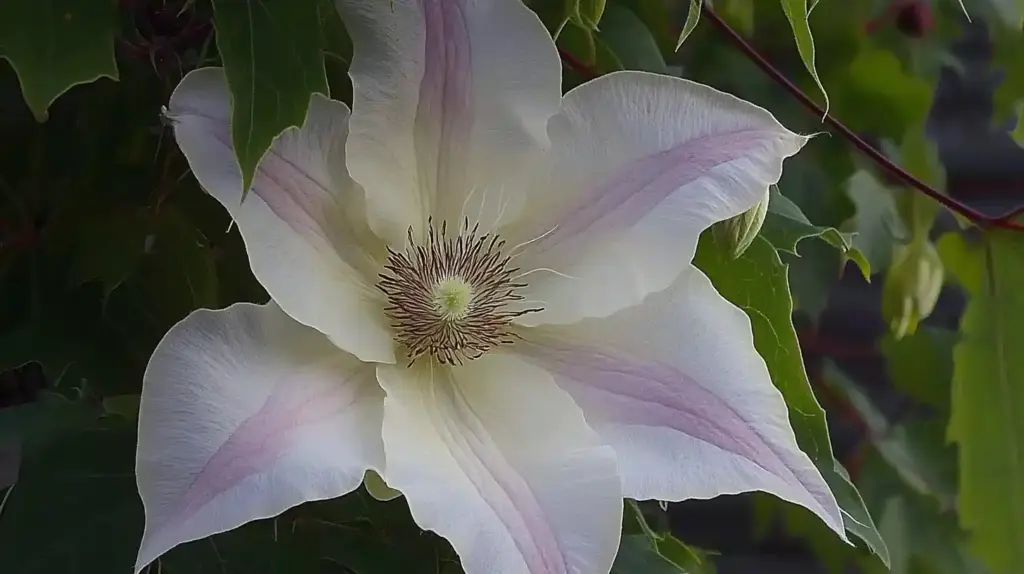
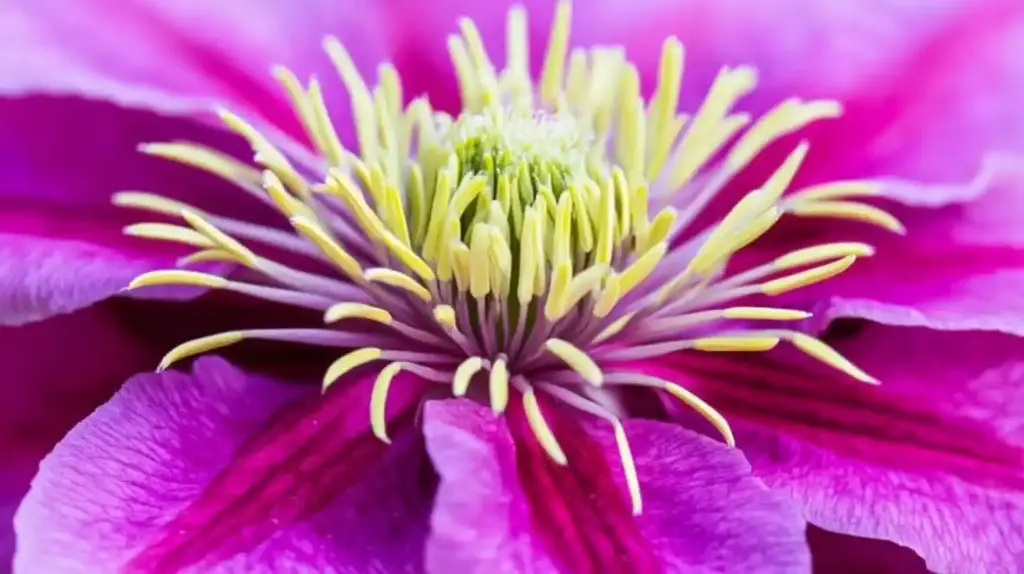
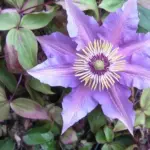
- ‘Bijou’
A petite vine that delivers full-sized, deep purple flowers with a silvery reverse. Perfect for patio pots or even as a groundcover, thanks to its non-aggressive habit. - Boulevard® Alaina
Vibrant bubblegum-pink flowers on a compact plant make Alaina perfect for small gardens or balconies. Reblooming ensures color all season. - Boulevard® Kitty™
Rounded white blooms touched with green, ideal for hanging baskets or container displays in part shade.
🔔 Unique Flower Shapes
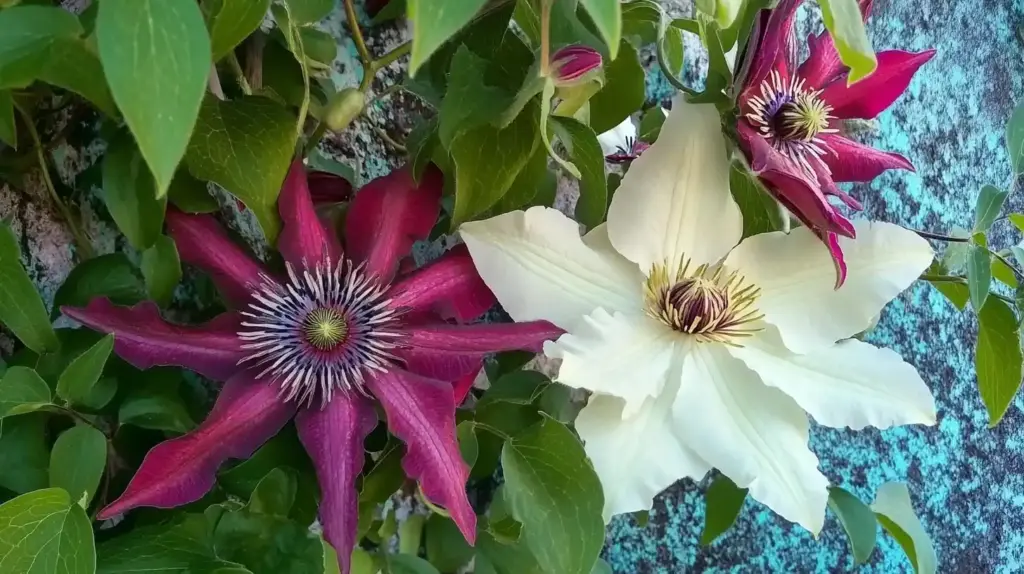
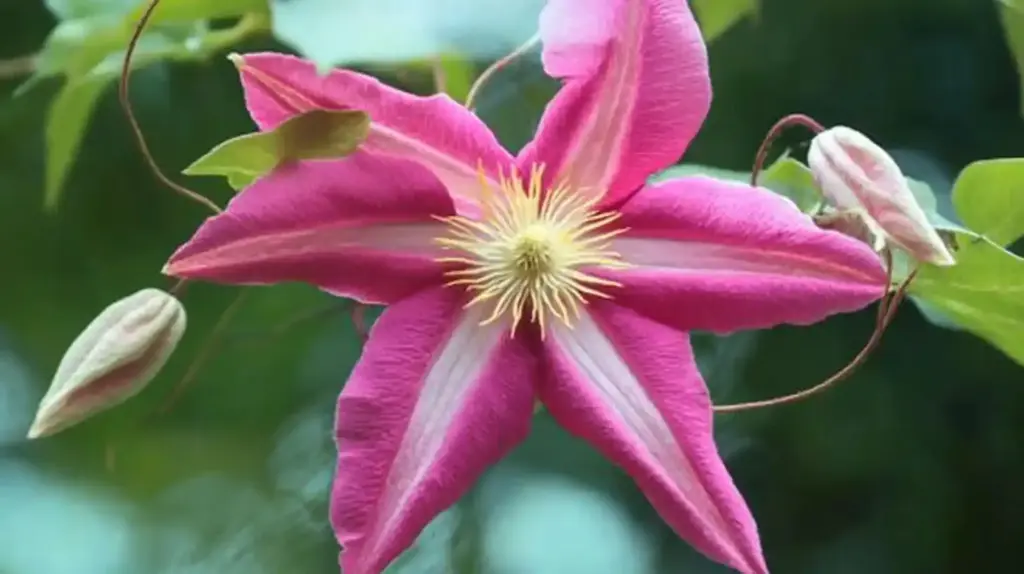
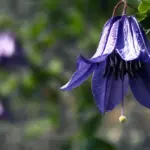
- ‘Roguchi’
Bell-shaped, deep violet-blue flowers with a strong fragrance. This variety doesn’t need support and weaves naturally through other plants. - ‘Princess Diana’
Bright pink, tulip-like blooms that add a bold and modern shape to vertical spaces. A prolific rebloomer that shines from midsummer into fall. - Avant Garde
An eye-catching two-tone bloom—magenta petals with a pink, dahlia-like center—makes this clematis a conversation starter on trellises or pergolas.
🌟 Hardworking & Low Maintenance
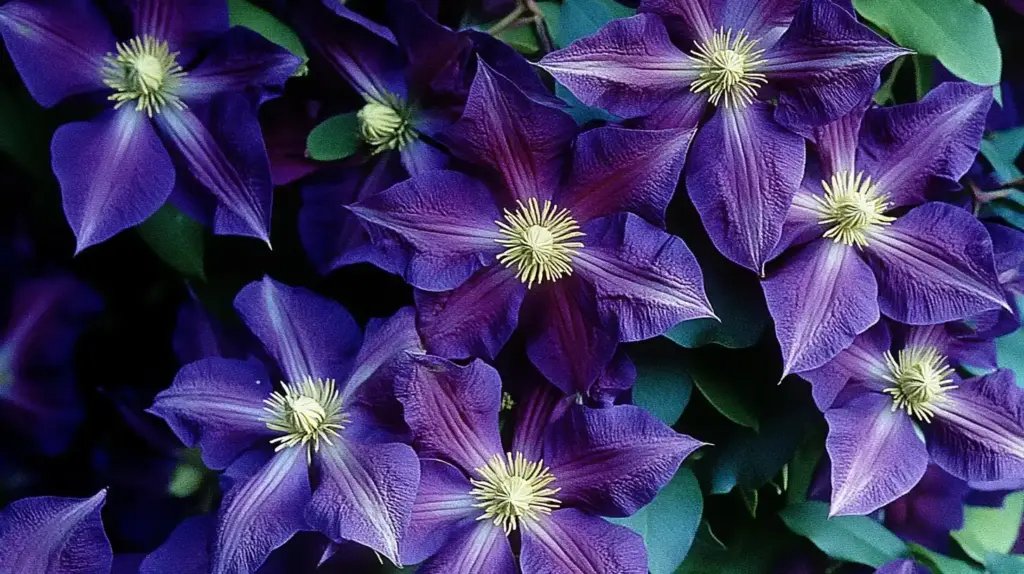

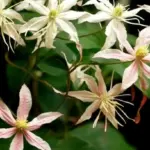
- Sapphire Indigo™
A free-flowering, bushy clematis that doubles as a groundcover or short climber. Its deep indigo blooms are perfect for low fences or spilling over garden beds. - Sweet Autumn Clematis
One of the latest bloomers, this variety covers itself in tiny white fragrant flowers from late summer into fall. Perfect for covering large spaces quickly. - Jackman Superba
A prolific purple bloomer that flowers from summer to frost. Ideal for large trellises or privacy screens.
🌱 Types of Clematis by Growth and Flower Form
Not all types of clematis grow the same way. Some are towering climbers perfect for fences and arbors, while others stay compact, making them perfect for patios or small garden beds. Understanding these growth habits will help you pick the ideal variety for your landscape.
🏞️ Clematis Montana Varieties: Early-Blooming Powerhouses
Clematis montana types are among the earliest to bloom in spring and are known for their vigorous growth and clouds of small, fragrant flowers. They quickly cover large structures, walls, and pergolas with soft pink or white blooms and are perfect for gardeners wanting quick coverage.
Try:
- ‘Rubens’ – Light pink blooms and bronze foliage
- ‘Pink Anemone’ – Mauve-pink flowers with a lovely vanilla scent
🌸 Large-Flowered Hybrids: The Garden Classics
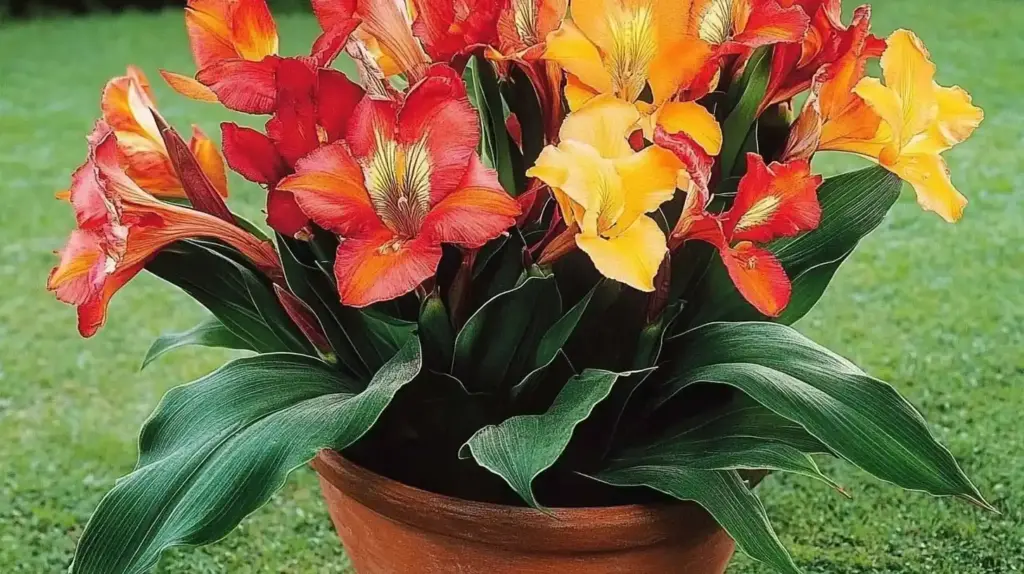
These are the most iconic and widely grown types of clematis, known for their striking, often dinner-plate-sized flowers and long blooming periods. Many rebloom with proper pruning and care.
Try:
- ‘Henryi’ – Pure white blooms with dark anthers
- ‘Crystal Fountain’ – Semi-double blue flowers with a silvery center
- ‘Cardinal Wyszynski’ – Vibrant crimson blooms with a bold presence
🌼 Small-Flowered Clematis: Delicate Beauty
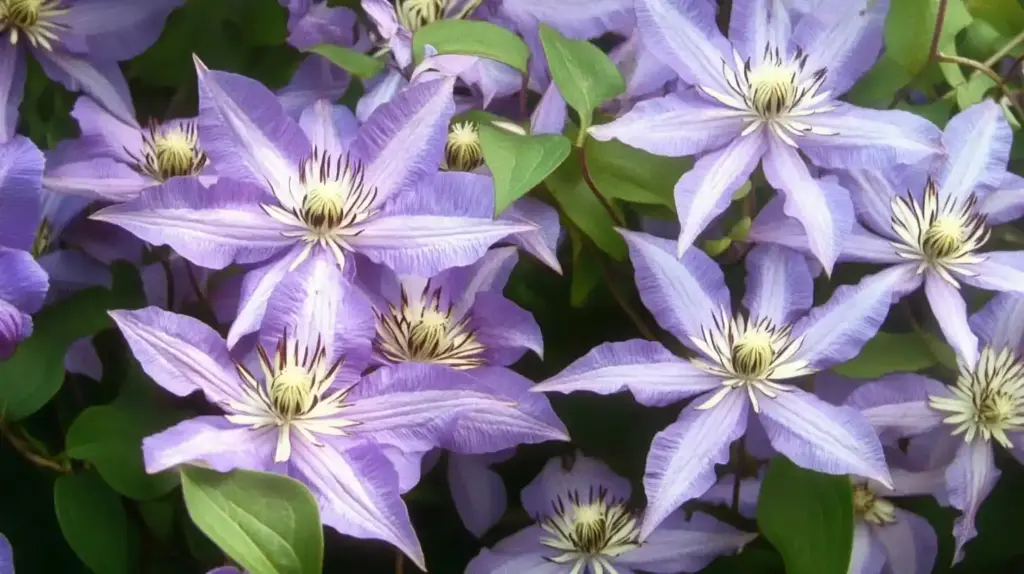
What small-flowered clematis lack in bloom size, they make up for in charm, fragrance, and pollinator appeal. These varieties often resemble wildflowers and are great in informal or cottage gardens.
Try:
- ‘Roguchi’ – Deep purple bell-shaped flowers with a long bloom season
- ‘Sweet Summer Love’ – Fragrant red-to-purple star-shaped blooms that cover the vine for months
🌿 Herbaceous Clematis: Bush-Forming Beauties
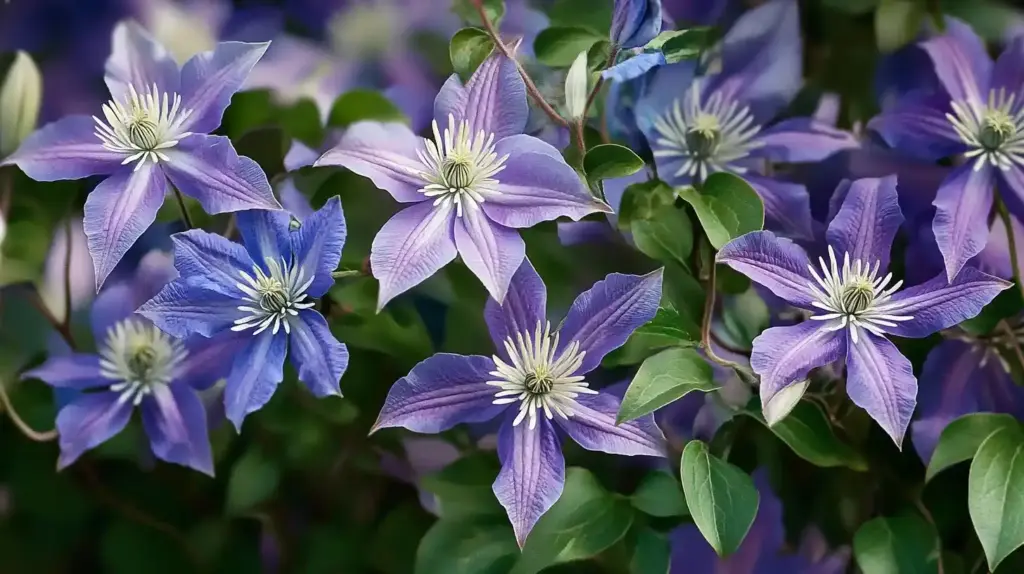
These non-climbing clematis varieties behave more like perennials, dying back in winter and reemerging in spring. They’re ideal for flower beds or mixed borders, especially where vertical space is limited.
Try:
- ‘Stand by Me’ – A true bush clematis with blue bell-shaped blooms
- ‘Double Rose™’ – Compact with elegant pale pink flowers and repeat blooms
🌍 Groundcover Clematis: Spreading and Spilling Charm
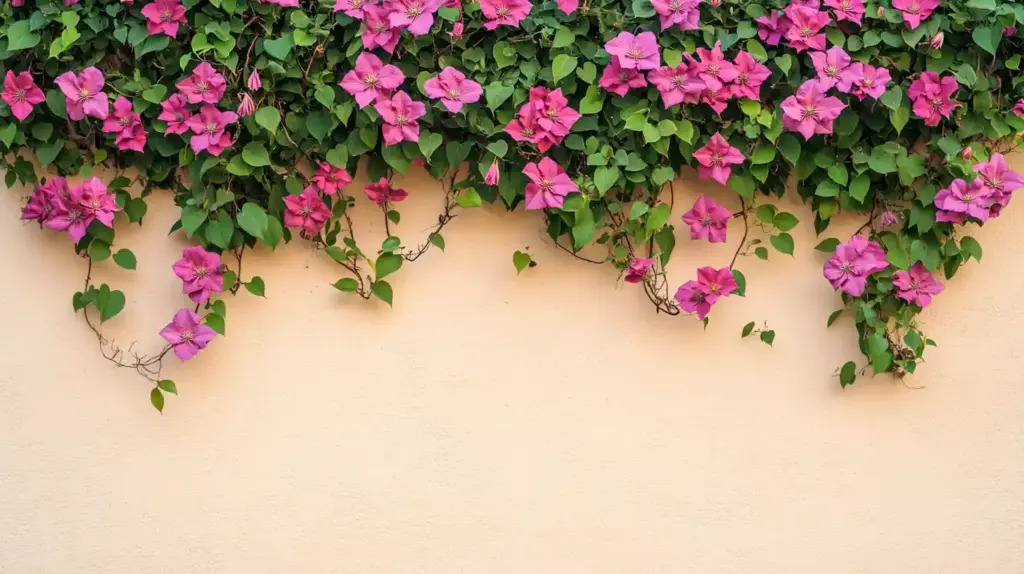
If you’re short on vertical space or want a clematis to trail over walls or across the ground, these low-growing cultivars are just the ticket. They’re often compact, free-flowering, and great in containers or rock gardens.
Try:
- ‘Bijou’ – Compact yet bold purple flowers
- ‘Sapphire Indigo™’ – A mounding grower that shines as a cascading groundcover or in raised beds
🛠️ General Clematis Care Tips for Healthy, Thriving Vines

No matter which types of clematis you choose, these care fundamentals will help ensure strong growth and abundant blooms. Clematis are generally low-maintenance once established, but they do have a few unique preferences that make all the difference.
🌞 Sunlight: “Head in the Sun, Feet in the Shade”
Most clematis varieties prefer full sun—at least 6 hours daily—but their roots like it cool. Use mulch, groundcovers, or low-growing plants to shade the base of the vine while letting the foliage and flowers soak up the sunshine.
🌱 Soil: Rich, Well-Drained, and Alkaline
Clematis need deep, fertile, and porous soil. Add compost or aged manure when planting, and check that the pH leans slightly alkaline (6.5–7.5). Avoid heavy, waterlogged soils.
Pro Tip: Mix a little garden lime into the planting hole if your soil tends to be acidic.
✂️ Pruning: Know Your Group (1, 2, or 3)
Correct pruning encourages healthy vines and repeat blooms. Clematis fall into three pruning groups:
- Group 1: Blooms on old wood; prune lightly after flowering (e.g., Clematis montana).
- Group 2: Blooms on both old and new wood; prune to shape in early spring and deadhead after flowering.
- Group 3: Blooms on new wood; prune hard in late winter/early spring to about 12 inches from the ground.
Important: Always check your variety’s group before pruning to avoid cutting off future blooms!
🪜 Support Structures: Give Them Something to Climb
Clematis vines climb using leaf petioles (leaf stems), which need something slender to grab—like netting, trellis wire, or thin twine. Before planting, install your support structure to avoid disturbing the roots later.
💧 Watering & Mulching
Keep soil consistently moist during the growing season, especially in the first year. Once established, clematis are moderately drought-tolerant but appreciate regular watering in dry spells.
Use 2–3 inches of mulch to retain moisture, suppress weeds, and insulate the roots.
🐝 Companion Planting & Pollinator Support
Clematis attract butterflies, bees, and hummingbirds—especially fragrant and small-flowered types. Pair with pollinator-friendly plants like lavender, coneflowers, or nepeta for an even more vibrant garden.
❓ Frequently Asked Questions About Types of Clematis
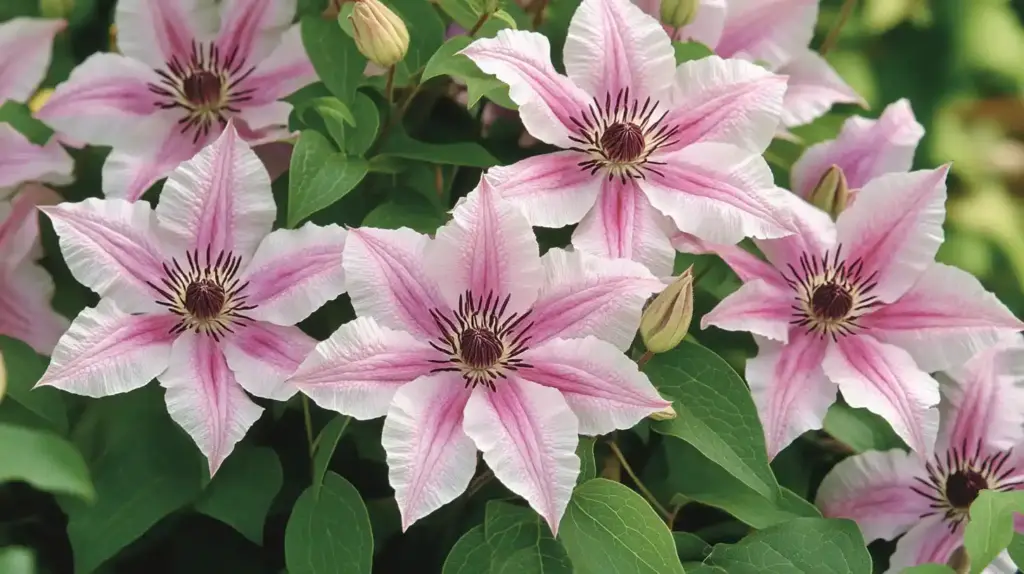
🌿 What is the easiest clematis to grow?
Some of the easiest clematis varieties for beginners include ‘Nelly Moser’, ‘Jackmanii’, and ‘Sweet Autumn Clematis’. These types are hardy, forgiving, and bloom reliably with minimal care.
☀️ Do clematis prefer sun or shade?
Most clematis thrive in full sun, needing at least 6 hours daily. However, they like their roots shaded and cool, which is why mulching or planting low-growing companions at the base is essential.
✂️ When should clematis be pruned?
Clematis pruning depends on its group classification:
- Group 1: Prune after flowering (spring bloomers)
- Group 2: Light prune in early spring and after first bloom
- Group 3: Hard prune in late winter/early spring
Always check your plant’s tag or cultivar info.
🌸 How long do clematis bloom?
Clematis bloom times vary. Some varieties like ‘Rebecca’ or ‘Bijou’ bloom twice a season, while others like Sweet Autumn Clematis bloom late and continuously into fall.
🌱 Can clematis grow in containers?
Yes! Many compact types of clematis, such as Boulevard® Kitty™, Alaina, or Sapphire Indigo™, are perfect for patios, balconies, or hanging baskets. Just ensure the pot is deep and has a support structure.
🌟 Conclusion
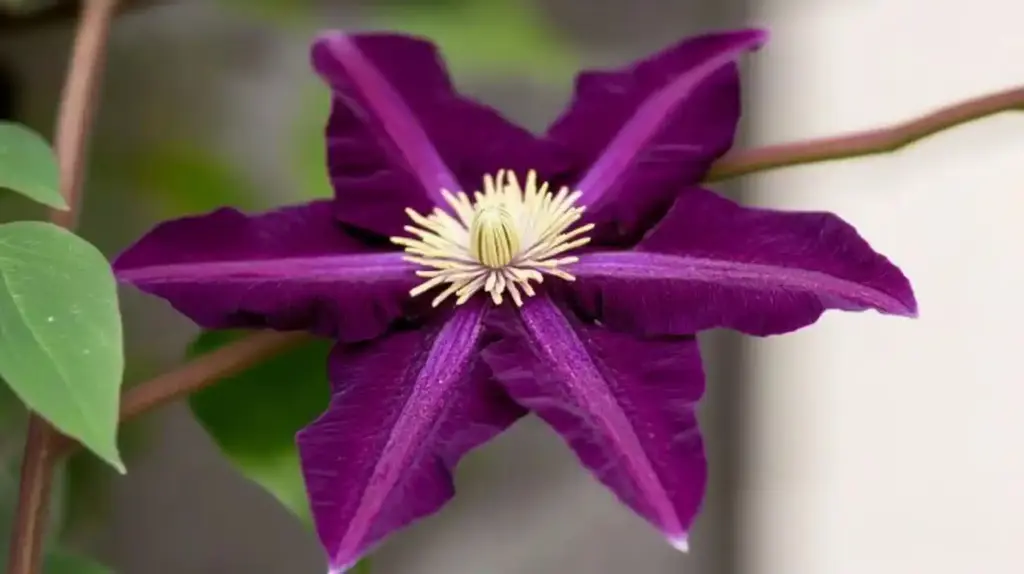
With so many unique types of clematis available, choosing the right one for your garden might seem overwhelming—but it doesn’t have to be. Whether you’re dreaming of a compact patio variety, a vigorous climber to cover fences, or a fragrant groundcover that spills beautifully over beds, there are types of clematis that fit every garden design and size.
From early-blooming Montana cultivars to the long-flowering Boulevard® series, each clematis offers something special—be it color, form, fragrance, or resilience. Understanding your chosen variety’s pruning group, bloom habit, and sunlight needs will help you grow them successfully for years to come.
Ready to get started? Whether you’re planting in the ground or experimenting with a beautiful container display, don’t miss our guide on how to grow clematis in containers for practical, beginner-friendly advice.
So go ahead—pick your favorite types of clematis, give them the support they need, and let your garden burst with vibrant color and charm season after season.

